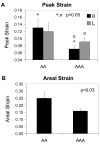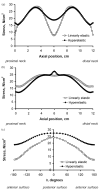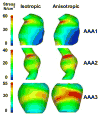Biomechanics of abdominal aortic aneurysm
- PMID: 17254589
- PMCID: PMC2692528
- DOI: 10.1016/j.jbiomech.2006.09.003
Biomechanics of abdominal aortic aneurysm
Abstract
Abdominal aortic aneurysm (AAA) is a condition whereby the terminal aorta permanently dilates to dangerous proportions, risking rupture. The biomechanics of AAA has been studied with great interest since aneurysm rupture is a mechanical failure of the degenerated aortic wall and is a significant cause of death in developed countries. In this review article, the importance of considering the biomechanics of AAA is discussed, and then the history and the state-of-the-art of this field is reviewed--including investigations into the biomechanical behavior of AAA tissues, modeling AAA wall stress and factors which influence it, and the potential clinical utility of these estimates in predicting AAA rupture.
Figures












References
-
- Adolph R, Vorp DA, Steed DL, Webster MW, Kameneva MV, Watkins SC. Cellular content and permeability of intraluminal thrombus in abdominal aortic aneurysm. Journal of Vascular Surgery. 1997;25:916–26. - PubMed
-
- Asbury CL, Ruberti JW, Bluth EI, Peattie RA. Experimental investigation of steady flow in rigid models of abdominal aortic aneurysms. Annals of Biomedical Engineering. 1995;23:29–39. - PubMed
-
- Ashton HA, Buxton MJ, Day NE, Kim LG, Marteau TM, Scott RA, Thompson SG, Walker NM Multicentre Aneurysm Screening Study G. The multicentre aneurysm screening study (mass) into the effect of abdominal aortic aneurysm screening on mortality in men: A randomised controlled trial.[see comment] Lancet. 2002;360:1531–9. - PubMed
-
- Bengtsson H, Sonesson B, Bergqvist D. Incidence and prevalence of abdominal aortic aneurysms, estimated by necropsy studies and population screening by ultrasound. Proceedings, Volume 800 of the Annals of the New York Academy of Sciences; United States. 1996. - PubMed
Publication types
MeSH terms
Grants and funding
LinkOut - more resources
Full Text Sources
Other Literature Sources

